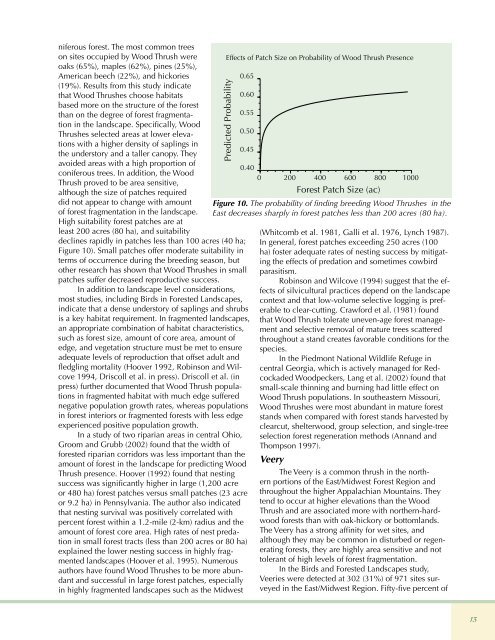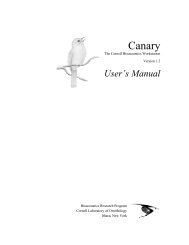A Land Manager's Guide to Improving Habitat for Forest Thrushes
A Land Manager's Guide to Improving Habitat for Forest Thrushes
A Land Manager's Guide to Improving Habitat for Forest Thrushes
You also want an ePaper? Increase the reach of your titles
YUMPU automatically turns print PDFs into web optimized ePapers that Google loves.
niferous <strong>for</strong>est. The most common trees<br />
on sites occupied by Wood Thrush were<br />
oaks (65%), maples (62%), pines (25%),<br />
American beech (22%), and hickories<br />
(19%). Results from this study indicate<br />
that Wood <strong>Thrushes</strong> choose habitats<br />
based more on the structure of the <strong>for</strong>est<br />
than on the degree of <strong>for</strong>est fragmentation<br />
in the landscape. Specifically, Wood<br />
<strong>Thrushes</strong> selected areas at lower elevations<br />
with a higher density of saplings in<br />
the unders<strong>to</strong>ry and a taller canopy. They<br />
avoided areas with a high proportion of<br />
coniferous trees. In addition, the Wood<br />
Thrush proved <strong>to</strong> be area sensitive,<br />
although the size of patches required<br />
did not appear <strong>to</strong> change with amount<br />
of <strong>for</strong>est fragmentation in the landscape.<br />
High suitability <strong>for</strong>est patches are at<br />
least 200 acres (80 ha), and suitability<br />
Predicted Probability<br />
Effects of Patch Size on Probability of Wood Thrush Presence<br />
0.65<br />
0.60<br />
0.55<br />
0.50<br />
0.45<br />
0.40<br />
declines rapidly in patches less than 100 acres (40 ha;<br />
Figure 10). Small patches offer moderate suitability in<br />
terms of occurrence during the breeding season, but<br />
other research has shown that Wood <strong>Thrushes</strong> in small<br />
patches suffer decreased reproductive success.<br />
In addition <strong>to</strong> landscape level considerations,<br />
most studies, including Birds in <strong>Forest</strong>ed <strong>Land</strong>scapes,<br />
indicate that a dense unders<strong>to</strong>ry of saplings and shrubs<br />
is a key habitat requirement. In fragmented landscapes,<br />
an appropriate combination of habitat characteristics,<br />
such as <strong>for</strong>est size, amount of core area, amount of<br />
edge, and vegetation structure must be met <strong>to</strong> ensure<br />
adequate levels of reproduction that offset adult and<br />
fledgling mortality (Hoover 1992, Robinson and Wilcove<br />
1994, Driscoll et al. in press). Driscoll et al. (in<br />
press) further documented that Wood Thrush populations<br />
in fragmented habitat with much edge suffered<br />
negative population growth rates, whereas populations<br />
in <strong>for</strong>est interiors or fragmented <strong>for</strong>ests with less edge<br />
experienced positive population growth.<br />
In a study of two riparian areas in central Ohio,<br />
Groom and Grubb (2002) found that the width of<br />
<strong>for</strong>ested riparian corridors was less important than the<br />
amount of <strong>for</strong>est in the landscape <strong>for</strong> predicting Wood<br />
Thrush presence. Hoover (1992) found that nesting<br />
success was significantly higher in large (1,200 acre<br />
or 480 ha) <strong>for</strong>est patches versus small patches (23 acre<br />
or 9.2 ha) in Pennsylvania. The author also indicated<br />
that nesting survival was positively correlated with<br />
percent <strong>for</strong>est within a 1.2-mile (2-km) radius and the<br />
amount of <strong>for</strong>est core area. High rates of nest predation<br />
in small <strong>for</strong>est tracts (less than 200 acres or 80 ha)<br />
explained the lower nesting success in highly fragmented<br />
landscapes (Hoover et al. 1995). Numerous<br />
authors have found Wood <strong>Thrushes</strong> <strong>to</strong> be more abundant<br />
and successful in large <strong>for</strong>est patches, especially<br />
in highly fragmented landscapes such as the Midwest<br />
0 200 400 600 800 1000<br />
<strong>Forest</strong> Patch Size (ac)<br />
Figure 10. The probability of finding breeding Wood <strong>Thrushes</strong> in the<br />
East decreases sharply in <strong>for</strong>est patches less than 200 acres (80 ha).<br />
(Whitcomb et al. 1981, Galli et al. 1976, Lynch 1987).<br />
In general, <strong>for</strong>est patches exceeding 250 acres (100<br />
ha) foster adequate rates of nesting success by mitigating<br />
the effects of predation and sometimes cowbird<br />
parasitism.<br />
Robinson and Wilcove (1994) suggest that the effects<br />
of silvicultural practices depend on the landscape<br />
context and that low-volume selective logging is preferable<br />
<strong>to</strong> clear-cutting. Craw<strong>for</strong>d et al. (1981) found<br />
that Wood Thrush <strong>to</strong>lerate uneven-age <strong>for</strong>est management<br />
and selective removal of mature trees scattered<br />
throughout a stand creates favorable conditions <strong>for</strong> the<br />
species.<br />
In the Piedmont National Wildlife Refuge in<br />
central Georgia, which is actively managed <strong>for</strong> Redcockaded<br />
Woodpeckers, Lang et al. (2002) found that<br />
small-scale thinning and burning had little effect on<br />
Wood Thrush populations. In southeastern Missouri,<br />
Wood <strong>Thrushes</strong> were most abundant in mature <strong>for</strong>est<br />
stands when compared with <strong>for</strong>est stands harvested by<br />
clearcut, shelterwood, group selection, and single-tree<br />
selection <strong>for</strong>est regeneration methods (Annand and<br />
Thompson 1997).<br />
Veery<br />
The Veery is a common thrush in the northern<br />
portions of the East/Midwest <strong>Forest</strong> Region and<br />
throughout the higher Appalachian Mountains. They<br />
tend <strong>to</strong> occur at higher elevations than the Wood<br />
Thrush and are associated more with northern-hardwood<br />
<strong>for</strong>ests than with oak-hickory or bot<strong>to</strong>mlands.<br />
The Veery has a strong affinity <strong>for</strong> wet sites, and<br />
although they may be common in disturbed or regenerating<br />
<strong>for</strong>ests, they are highly area sensitive and not<br />
<strong>to</strong>lerant of high levels of <strong>for</strong>est fragmentation.<br />
In the Birds and <strong>Forest</strong>ed <strong>Land</strong>scapes study,<br />
Veeries were detected at 302 (31%) of 971 sites surveyed<br />
in the East/Midwest Region. Fifty-five percent of<br />
13

















